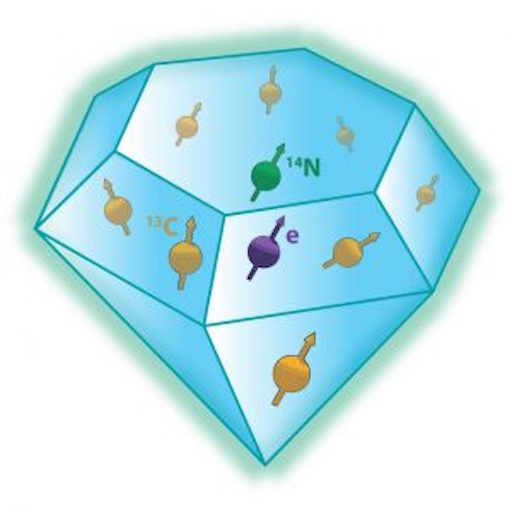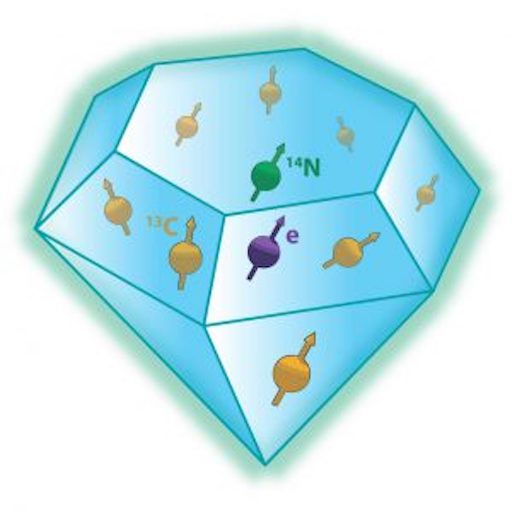Qubits
The computational power of a quantum computer is expected to far exceed that of a conventional computer. There are many candidates for the ‘qubit’, the basic building block of such a (future) quantum computer. One promising type of qubits are the spins of individual particles in solids, such as electrons and nuclei.
PhD-researcher and first author Conor Bradley of QuTech (a collaboration between TU Delft and TNO) explains: ‘In our case, we work with electron and nuclear spins. This has important advantages, as the different types of spins fulfill different roles. Electron spins, for example, offer fast control and high-quality readout. Coupling to light (photons) allows entanglement between qubits, even over long distances. Finally, the nuclear spins provide additional qubits with high stability (long coherence times) that can be used to store and process quantum information.’
Defects in diamond
‘Working at a temperature of 3.7 K (-269.5°C), we have studied the electron spin and the nuclear spin of a single nitrogen-vacancy center in diamond, together with nearby carbon-13 nuclear spins’, adds Tim Taminiau, who supervised the study. ‘A nitrogen vacancy is a defect in the lattice structure that occurs naturally in diamond. Basically, there is a nitrogen atom where a carbon atom should be. The highly pure diamond material we used was provided through our research cooperation with Element Six.’
Control
This spin-based qubit-system has many advantages, but controlling individual spins within these complex and strongly-interacting spin systems is a significant challenge. So far, these systems have been limited to a few qubits, with entangled states of just three spins demonstrated. Realizing larger multi-qubit systems is challenging, but is of course essential to realizing advanced computational power.
‘In this paper, we present a novel method to realize a 10-qubit quantum system, consisting of the electron spin of a nitrogen-vacancy center, and nine neighboring nuclear spins in diamond’, says Bradley. The scientists have achieved this by carefully suppressing unwanted interactions between the individual spins by decoupling them, while, at the same time, keeping the interactions that realize the desired computation. This new control technique allows them to engage nuclear spins in a wider area around the nitrogen vacancy center, whereas before, control was limited to spins located in more specific directions.
The computational power of a quantum computer is expected to far exceed that of a conventional computer. There are many candidates for the ‘qubit’, the basic building block of such a (future) quantum computer. One promising type of qubits are the spins of individual particles in solids, such as electrons and nuclei.
PhD-researcher and first author Conor Bradley of QuTech (a collaboration between TU Delft and TNO) explains: ‘In our case, we work with electron and nuclear spins. This has important advantages, as the different types of spins fulfill different roles. Electron spins, for example, offer fast control and high-quality readout. Coupling to light (photons) allows entanglement between qubits, even over long distances. Finally, the nuclear spins provide additional qubits with high stability (long coherence times) that can be used to store and process quantum information.’
Defects in diamond
‘Working at a temperature of 3.7 K (-269.5°C), we have studied the electron spin and the nuclear spin of a single nitrogen-vacancy center in diamond, together with nearby carbon-13 nuclear spins’, adds Tim Taminiau, who supervised the study. ‘A nitrogen vacancy is a defect in the lattice structure that occurs naturally in diamond. Basically, there is a nitrogen atom where a carbon atom should be. The highly pure diamond material we used was provided through our research cooperation with Element Six.’
Control
This spin-based qubit-system has many advantages, but controlling individual spins within these complex and strongly-interacting spin systems is a significant challenge. So far, these systems have been limited to a few qubits, with entangled states of just three spins demonstrated. Realizing larger multi-qubit systems is challenging, but is of course essential to realizing advanced computational power.
‘In this paper, we present a novel method to realize a 10-qubit quantum system, consisting of the electron spin of a nitrogen-vacancy center, and nine neighboring nuclear spins in diamond’, says Bradley. The scientists have achieved this by carefully suppressing unwanted interactions between the individual spins by decoupling them, while, at the same time, keeping the interactions that realize the desired computation. This new control technique allows them to engage nuclear spins in a wider area around the nitrogen vacancy center, whereas before, control was limited to spins located in more specific directions.

The researchers have realized a 10-qubit quantum system, consisting of the electron spin (purple) and nuclear spin (green) of a nitrogen vacancy center, and eight neighboring carbon-13 nuclear spins (yellow) in diamond.
Record
Taminiau: ‘We were able to demonstrate a fully controllable 10-qubit system and have shown that the system is fully connected by generating quantum entanglement between all 45 possible qubit pairs. We have also prepared genuine 7-qubit entanglement. The spins that we study are excellent quantum memories that can store quantum states for up to one minute.’ This combination of 10 qubits and long coherence times sets a new record for solid-state qubits. Furthermore, Taminiau expects that their new methods can also be applied to many other spin platforms in diamond, silicon and silicon carbide. ‘Our findings pave the way for advanced quantum algorithms, quantum error correction and large multi-qubit quantum networks based on tens of solid-state spin qubits.’
The Taminiau lab at TU Delft belongs to QuTech and the Kavli Institute of Nanoscience. The work was supported by the Netherlands Organisation for Scientific Research (NWO/OCW).
Taminiau: ‘We were able to demonstrate a fully controllable 10-qubit system and have shown that the system is fully connected by generating quantum entanglement between all 45 possible qubit pairs. We have also prepared genuine 7-qubit entanglement. The spins that we study are excellent quantum memories that can store quantum states for up to one minute.’ This combination of 10 qubits and long coherence times sets a new record for solid-state qubits. Furthermore, Taminiau expects that their new methods can also be applied to many other spin platforms in diamond, silicon and silicon carbide. ‘Our findings pave the way for advanced quantum algorithms, quantum error correction and large multi-qubit quantum networks based on tens of solid-state spin qubits.’
The Taminiau lab at TU Delft belongs to QuTech and the Kavli Institute of Nanoscience. The work was supported by the Netherlands Organisation for Scientific Research (NWO/OCW).




 IonQ Achieves Industry Leading Performance on Next Generation Barium Qubits
IonQ Achieves Industry Leading Performance on Next Generation Barium Qubits